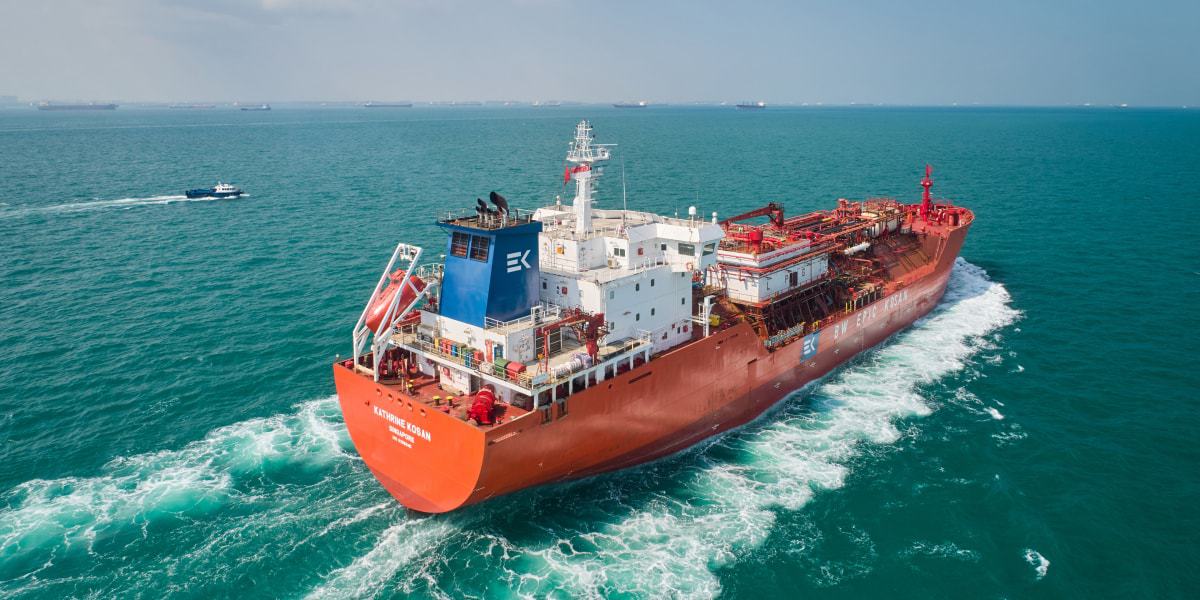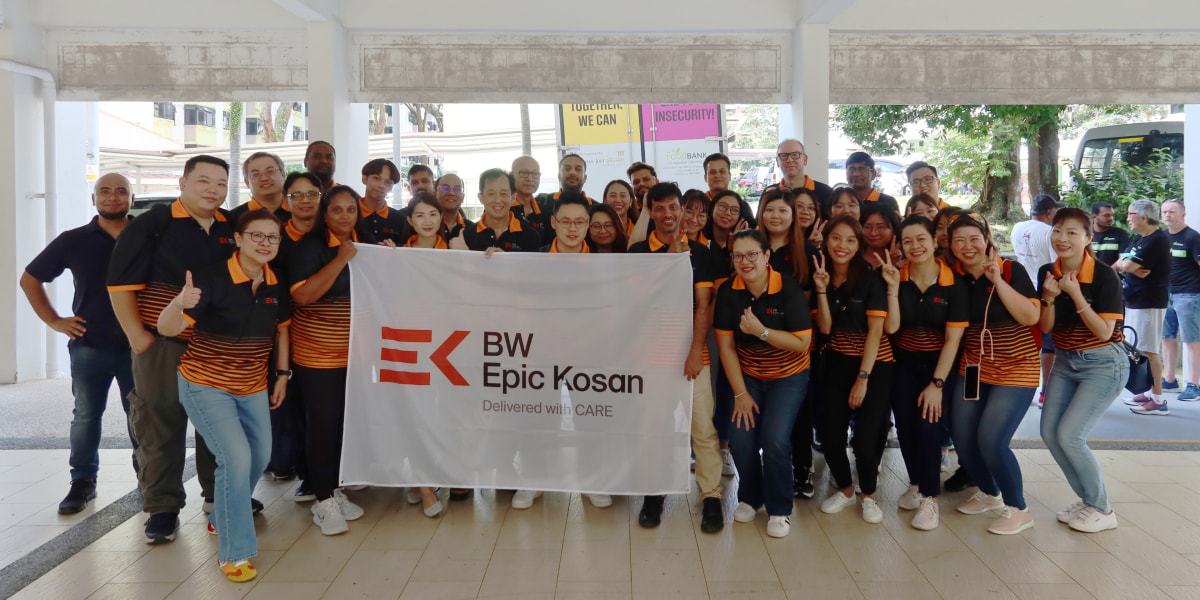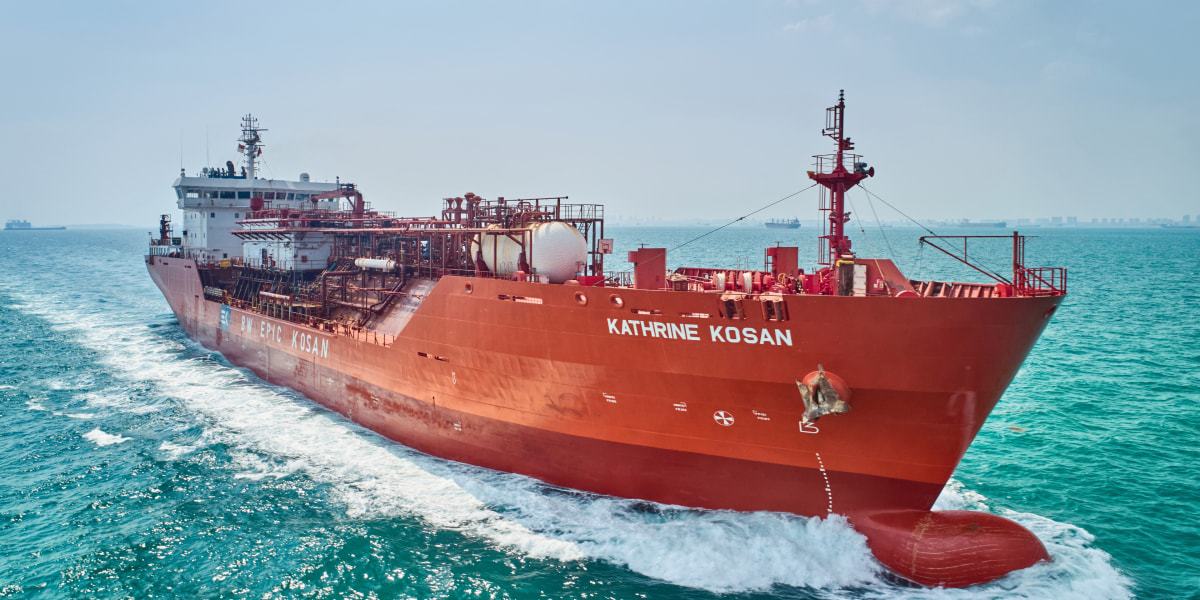Common Terms in Shipping
The shipping industry facilitates world trade — connecting domestic and global manufacturing centres with markets world-wide through transportation of commodities and finish products. This is a non-exhaustive summary of common terms used in the maritime energy transportation and shipping industry.
If there is terminology used on our website that you are unfamiliar with / require additional clarification on, please contact communications@bwek.com.
| S/N | Term | Definition |
|---|---|---|
| ABAC | Anti-Bribery and Anti-Corruption | |
| AER | Annual Efficiency Ratio uses an approximation of cargo carried by utilizing the vessel’s designed deadweight capacity in place of actual cargo carried and assumes the vessel is continuously carrying cargo AER of the fleet is calculated as the total CO2 emitted for all vessels / total Deadweight Tonnage X Distance Travelled for all vessels | |
| Ballast Water | Fresh or saltwater held in the ballast tanks and cargo holds of ships | |
| Ballast Water Management Convention | The International Convention for the Control and Management of Ships’ Ballast Water and Sediments (BWM Convention) requires vessels to comply with standards and procedures for the management and control of ships’ ballast water and sediments | |
| Baltic LPG Index | Baltic Exchange Liquid Petroleum Gas Index - An assessment of the daily spot charter rates of a vessel moving LPG between the Middle East and Japan | |
| BIMCO | Baltic and International Maritime Council - The largest international association representing shipowners | |
| Bunker Fuel | Any fuel used to power a ship’s engines | |
| CBM | Cubic meter - A unit of volume of a gas vessel’s capacity for carrying gas cargoes | |
| Charter | Hiring of a vessel, or use of its carrying capacity for either (i) a specified period of time (time-charter) or (ii) a specific voyage or set of voyages (voyage charter) | |
| CIF | Cost, Insurance, Freight - Rules covering the carriage of international goods by sea | |
| COA | Contract of Affreightment - Under a CoA, the shipowner provides capacity to transport a certain amount of cargo within a specified period from one place to a destination designated by the customer. All of the ship’s operating, voyage and capital costs are borne by the shipowner. The freight rate is normally agreed on a per cargo tonne basis. The freight rate can be fixed or floating, or a combination of both | |
| Commercial management | Marketing of vessels for business, negotiating and firming carriage of cargo contracts with customers and operating of vessels in accordance with the terms of the charter parties | |
| Dry Docking | Placing a vessel out of water alongside a dock for major repairs and surveys usually coinciding with periodical regulatory survey requirements of the vessel | |
| Dual-fuel engine | An engine that is able to run on both gas oil and another fuel such as LNG, LPG, ammonia or methanol | |
| EBITDA | Earnings Before Interest, Taxes, Depreciation and Amortisation | |
| ECA | Emission Control Area - Sea areas in which stricter controls were established to minimise airborne emissions from ships. Until 31 December 2019, the limit for sulphur content of ships’ fuel oil was 3.5% for vessels trading outside ECAs. Today, a global cap of 0.5% applies. | |
| EEDI | Energy Efficiency Design Index - An IMO measure designed to ensure the use of more energy efficient equipment and engines | |
| EEOI | Energy Efficiency Operaitonal Index monitors the energy efficiency of the vessel EEOI of the fleet is calculated as the total CO2 emitted for all vessels / total Amount of Cargo Carried X Cargo Distance Travelled for all vessels | |
| ESG | Environmental, social and governance | |
| Flag State | Administration offering vessel registration services and responsible for ensuring implementation of international conventions | |
| G&A | General and administrative expenses | |
| GHG | Greenhouse gases | |
| GHG Scope 1 Emissions | Direct greenhouse gas emissions from owned or controlled sources | |
| GHG Scope 2 Emissions | Indirect greenhouse gas emissions from the generation of purchased energy | |
| GRI | Global Reporting Initiative- An international standard for sustainability reporting | |
| HFO | Heavy Fuel Oil | |
| HSSEQ | Health, Safety, Security, Environment and Quality | |
| HSFO | Heavy Sulphur Fuel Oil | |
| ISO | International Organisation for Standardisation | |
| IFRS | International Financial Reporting Standards - An international standard for accounting and financial reporting | |
| IT | Information Technology | |
| IMO | International Maritime Organisation - A United Nations global standard-setting authority for the safety, security and environmental performance of international shipping | |
| IMO 2020 | A global regulation effective from 1 January 2020 requiring all ships to burn fuels with less than 0.5% sulphur or use emission abatement technologies | |
| ISM | International Safety Management Code - An international standard for the safe management and operation of ships and for pollution prevention | |
| LGC | Large Gas Carrier - Gas carrier of 50,000 - 70,000 CBM | |
| LNG | Liquified Natural Gas | |
| LPG | Liquefied Petroleum Gas | |
| LSMGO | Low Sulphur Mairne Gas Oil | |
| LTIF | Lost Time Injury Frequency Rate - A ratio of the number of lost time injuries occurring in a workplace per 1 million hours worked. An LTIFR of 7, for example, shows that 7 lost time injuries occur on a jobsite every 1 million hours worked. The formula gives a picture of how safe a workplace is for its workers | |
| LTIF | Long-term Incentive Program | |
| MACN | Maritime Anti-Corruption Network - A global business network working towards the vision of a maritime industry free of corruption | |
| MARPOL | International Convention for the Prevention of Pollution from Ships designed to prevent pollution from shipping | |
| MGO | Marine gas oil | |
| New Building/ New Build (NB) | A new vessel under construction | |
| Nm | Nautical mile | |
| NOx | Nitrogen Oxide | |
| Operating Expense (OPEX) | Vessel operating expenses, such as manning, insurance, maintenance and repairs | |
| P&I Club | Protection & Indemnity Club - A mutual insurance association providing risk pooling, information and representation for its shipowner members | |
| PM | Particulate matter | |
| Pool | Arrangement under which vessels owned by different owners are contributed into a pool. The manager of the pool markets the vessels as a single, cohesive fleet, operating them under spot contracts, CoAs and time-charters. The income from the vessels included in the pool is distributed to individual owners according to an agreed upon pool point system whereby each vessel receives its share of the pool’s earnings according to the vessel’s earning potential | |
| Port State Control | Inspection of ships to ensure that the ship and its equipment complies with international conventions | |
| Poseidon Principles | Framework developed by leading ship financiers for integrating climate considerations into lending decisions to promote international shipping’s decarbonisation | |
| QI | Qualified Individual - Under the US Oil Pollution Act, all vessels calling in US waters must ensure that a Qualified Individual is available to implement a response plan | |
| SASB | Sustainability Accounting Standards Board | |
| Scrubber | Emission abatement technology installed on a ship allowing it to burn high sulphur fuels | |
| SIRE | Ship Inspection Report Programme - A programme for evaluating and rating tanker vessels’ technical and safety standards, for use as a reference by oil and gas companies when utilising vessels | |
| SOx | Sulphur dioxide | |
| TCE Income | Time-Charter Income - Gross freight less voyage related costs | |
| TCFD | The Task Force on Climate-related Financial Disclosures | |
| Technical Management | Daily operation of a vessel, including maintenance, supplies and manning | |
| Time Charter | Under time-charters, vessels are chartered to customers for fixed periods of time at rates that are generally fixed. The charterer pays all voyage costs. The owner of the vessel receives monthly charter payments on a per day basis and is responsible for the payment of all vessel operating expenses (including manning, maintenance, repair and docking) and capital costs of the vessel | |
| Tonne-mile | Unit cargo x distance; i.e. 10 metric tonnes carried 25 miles = 250 tonne miles | |
| TRCF | Total Recordable Case Frequency - The sum of all work-related fatalities and injuries per one million hours worked over the quantity of hours worked | |
| UNSDG | United Nations’ Sustainable Development Goals | |
| Vessel Recycling | The sale of a vessel for dismantling and reprocessing the building materials | |
| VLGC | Very Large Gas Carrier - A gas carrier above 70,000 CBM | |
| VLSFO | Very Low Sulphur Fuel Oil | |
| Voyage Charter | Typically a single round trip that is priced on a current or spot market value. The owner of the vessel receives payment derived by multiplying the metric tonnes of cargo loaded on board by the agreed upon freight rate expressed on a per cargo metric tonne basis. The owner is responsible for the payment of all expenses including voyage expenses (including bunker fuel, agency and port costs), operating expenses and capital costs of the vessel | |
| WLPGA | World LPG Association - An international association representing over 250 companies involved in the LPG value chain | |
| Year on Year - YoY | Year on Year |
More Media About BW Epic Kosan
Learn more about us through our stories, galleries and documents.




